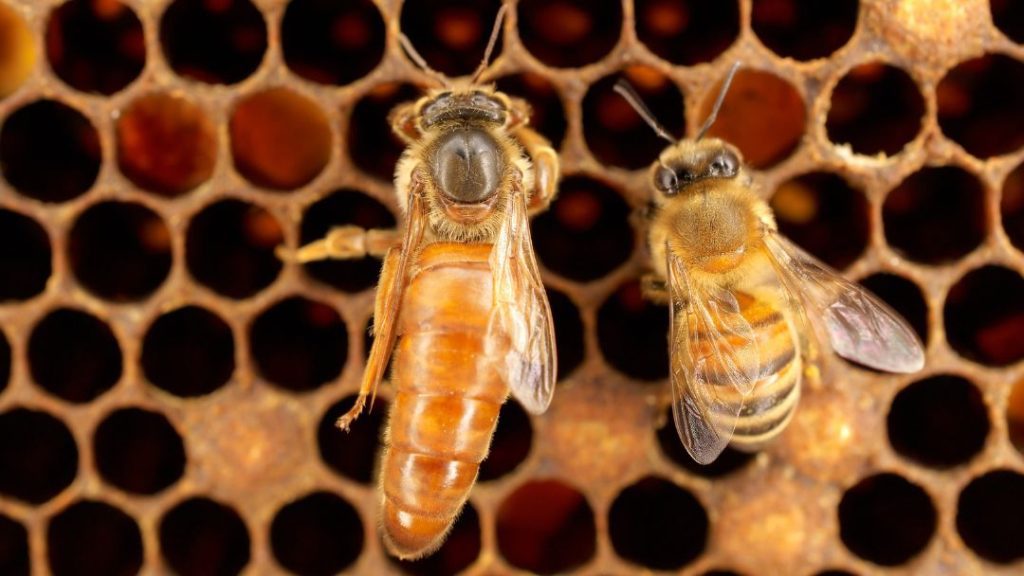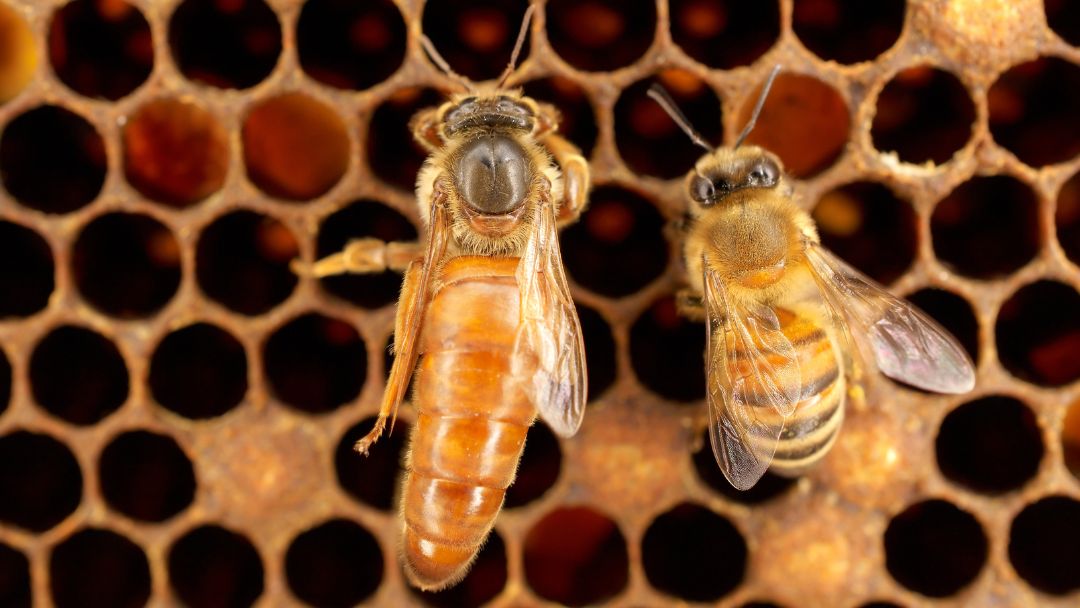Why Do Beehives Need a Queen: essential role and significance
Beehives need a queen to ensure reproduction and the continuation of the colony. The queen bee is responsible for laying eggs and maintaining the population of worker bees in the hive.
Having a queen is essential for the survival and success of the hive. In the intricate world of a beehive, every role plays a vital part in sustaining the colony’s existence. From the diligent worker bees to the efficient drones, each member contributes to the hive’s efficient functioning.
However, perhaps the most crucial and irreplaceable figure within the hive is the queen bee. The queen, a single dominant female, holds the key to the hive’s prosperity.
But what exactly is the reason behind such significance? Why do beehives need a queen? We will explore the indispensable role of the queen bee and unravel the importance of her presence in maintaining the sustainability of the beehive.
The Importance Of A Queen Bee In A Beehive
In a beehive, the queen bee plays a crucial role in the overall functioning and success of the colony.
As the central figure and leader of the colony, the queen bee is responsible for maintaining population and organization, ensuring the survival of the entire hive.
Let’s delve into the key reasons why a queen bee is indispensable in a beehive.
The Central Figure And Leader Of The Colony
The queen bee is the central figure and undeniably the leader of the colony. She is the only fertile female in the hive and is easily recognizable due to her larger size and distinctive appearance.
This regal bee emits a pheromone known as queen substance or queen pheromone, which serves as a powerful communication tool in the hive.
By producing this pheromone, the queen bee establishes herself as the dominant individual and commands obedience from the worker bees. This chemical messaging system helps maintain order, hierarchy, and collaboration within the colony.
It also indicates the presence of a fertile queen, which prevents other worker bees from developing ovaries and attempting to lay eggs, ensuring the smooth functioning of the hive.
Key Role In Reproduction And Colony Survival
One of the key responsibilities of the queen bee is reproduction, ensuring the survival and growth of the colony.
When a queen bee mates with drones (male bees), she stores the sperm in her body for future use. The stored sperm allows her to lay fertilized eggs throughout her lifetime, which can extend up to several years.
This ability to lay fertilized eggs is critical for the colony’s survival. The queen bee can lay over a thousand eggs per day, ensuring a continuous supply of worker bees, drones, and future queens.
Without a queen bee, the colony would eventually die out due to natural attrition or the inability to replace aging worker bees.
Responsible For Maintaining Population And Organization
Besides reproduction, the queen bee also performs the crucial task of maintaining the population and organization of the hive.
By laying eggs and controlling the colony’s growth, the queen bee ensures a stable and sufficient workforce for various hive tasks, such as foraging, nest building, and guard duty.
The queen bee has the remarkable ability to adjust egg-laying rates based on the colony’s needs. She can increase or decrease egg production, ensuring that the hive population aligns with available resources, hive conditions, and seasonal variations.
This flexibility in population control allows for efficient resource utilization and promotes the long-term survival of the colony.
Additionally, the queen bee plays a pivotal role in determining the social structure and hierarchy within the hive. By emitting queen pheromones, she establishes her authority and helps maintain order and cooperation among the worker bees.
This hierarchical structure enables effective division of labor and ensures that each bee has specific tasks aligned with its capabilities, contributing to the overall efficiency and success of the hive.

The Life Cycle Of A Queen Bee
The life cycle of a queen bee is a fascinating journey filled with various stages of development, each essential for the survival and growth of the beehive.
Understanding these stages helps us appreciate the significance of the queen bee in the overall functioning of the colony.
Let’s walk through the different stages of a queen bee’s development:
- The Egg Stage: It all begins with the queen bee laying eggs. She can lay up to 2,000 eggs in a day, each deposited in a specially constructed hexagonal cell. These eggs are tiny, roughly the size of a grain of rice, and have the potential to become worker bees or queens.
- The Larval Stage: After about three days, the eggs hatch into larvae. The worker bees take care of feeding and caring for the larvae. However, for a potential queen bee, the treatment is different. These larvae receive a special diet called royal jelly, a secretion produced by the worker bees to stimulate rapid growth and development. The royal jelly is rich in nutrients and hormones necessary for the queen bee to reach her full potential.
- The Pupal Stage: Once the larvae have grown in size, they enter the pupal stage. During this time, the larvae spin a silk cocoon around themselves, which acts as a protective covering. Inside the cocoon, the transformation from a tiny larva into an adult queen bee takes place. This stage usually lasts for about 16 days.
- The Mating Stage: After emerging from the pupal stage, the queen bee is now ready for mating. She flies out of the hive in search of males, known as drones. During these mating flights, the queen mates with several drones, storing their sperm inside her body for future use.
- The Egg-Laying Stage: Once the queen has mated, she returns to the hive and assumes her role as the egg-laying machine. She can lay hundreds or even thousands of eggs every day, ensuring the continuous population growth of the hive. The queen spends her entire life laying eggs while being fed and cared for by the worker bees.
Selection And Nurturing Of A Potential Queen Bee
The process of selecting and nurturing a potential queen bee is crucial for the beehive’s survival. Let’s explore how this process unfolds:
- Identifying Queen-Cell Candidates: The worker bees identify larvae that have the potential to become queens. They choose larvae from specially constructed queen cells that are larger and oriented vertically.
- Royal Jelly Diet: Once a queen-cell candidate is identified, she is fed a copious amount of royal jelly, a highly nutritious substance secreted by the worker bees. This special diet triggers specific genes in the larvae, enabling them to develop into queen bees.
- Cell Capping: After a few days, the queen-cell candidate is sealed within her cell with a wax cap. This indicates the start of the pupal stage, during which the transformation into an adult queen bee takes place.
- Emergence: Once fully developed, the new queen bee emerges from her cell, ready to take on her role as the leader of the hive.
The Process Of Mating And Establishing A New Colony
Upon reaching adulthood, the queen bee’s primary objective is to mate and establish a new colony. Here’s how this remarkable process unfolds:
- Mating Flights: The queen bee embarks on multiple mating flights, during which she seeks out drones from other colonies. These flights are essential for genetic diversity within the colony.
- Sperm Storage: During mating, the queen bee mates with several drones, storing their sperm inside her body. This sperm can be used to fertilize eggs throughout her lifespan, ensuring the production of worker bees.
- Colony Formation: After mating, the queen bee returns to the hive and begins laying fertilized eggs, which develop into worker bees. These worker bees take care of building the hive, collecting nectar and pollen, and feeding the growing population.
- Queen Succession: As the queen ages, her pheromone levels decrease, indicating that it is time for a new queen. The worker bees select a potential successor and begin the process of nurturing her, ensuring the longevity of the colony.
The life cycle of a queen bee is a complex and essential process for the survival of a beehive. Each stage plays a vital role in maintaining the colony’s strength and productivity.
Understanding these stages provides us with a deeper appreciation for the incredible world of bees.
The Queen Bee’s Role In Reproduction
Within the complex social structure of a beehive, the queen bee plays a pivotal role in the colony’s reproductive success. As the sole fertile female in the hive, the queen bee is responsible for the production of offspring, ensuring the colony’s survival and growth. Let’s delve deeper into the queen bee’s crucial role and its impact on the reproduction dynamics of the beehive.
Egg-laying Capabilities And Reproductive Dominance
The queen bee possesses remarkable egg-laying capabilities, which are essential for sustaining the colony’s population. The queen’s primary duty is to lay eggs, and she accomplishes this at an astonishing rate. During the peak of the season, a productive queen bee can lay up to 2,000 eggs in a single day!
Her reproductive dominance is further emphasized by the fact that she is the only female bee in the hive that can mate and produce viable eggs. Unlike the worker bees, the queen has fully developed reproductive organs, allowing her to mate with drones and lay fertilized eggs.
This reproductive monopoly is attained through pheromonal mediation, as the queen releases a potent substance called queen pheromones. These pheromones suppress the reproductive capabilities of the worker bees, ensuring that they do not lay eggs and disrupt the colony’s reproductive hierarchy.
Ensuring Genetic Diversity Within The Colony
Another critical role of the queen bee is to ensure genetic diversity within the colony. To achieve this, the queen mates with several drones on a single mating flight. These drones come from neighboring colonies, contributing to the introduction of new genetic material in the offspring.
By diversifying the genetic pool, the queen bee helps to strengthen the colony’s overall resilience and adaptability. The genetic variability promotes resistance to diseases, enhances foraging efficiencies, and allows the colony to thrive in different environmental conditions.
Maintaining A Balanced Ratio Of Worker Bees And Drones
The queen bee plays a vital role in maintaining a balanced ratio of worker bees and drones within the beehive. The queen determines the sex of each egg she lays by controlling whether it is fertilized or not.
Fertilized eggs, which will develop into female workers, receive sperm from the queen during reproduction. On the other hand, unfertilized eggs, which will become drones, do not receive any sperm. This controlled sex determination process helps to optimize the workforce composition, ensuring that the hive has an adequate number of worker bees for essential tasks such as foraging, nursing the brood, and maintaining hive hygiene, while also maintaining an appropriate number of drones for mating purposes.
The queen bee’s role in reproduction is unique and multifaceted, ensuring the survival, growth, and genetic diversity of the beehive. By understanding the significance of the queen bee, we gain a deeper appreciation for the intricate mechanisms that contribute to the success of these remarkable and fascinating insect colonies.
Queen Bee’s Communication And Organization
Pheromone Production And Its Effects On The Colony
In the complex and highly organized world of a beehive, communication plays a vital role in ensuring the colony’s survival. At the heart of this communication network lies the queen bee. One fascinating aspect of the queen bee’s role is her ability to produce and release pheromones, chemical compounds that convey important messages to other bees.
Pheromones are not just any ordinary scents; they are specifically designed to influence the behavior and social structure within the hive. The queen bee releases a variety of pheromones that affect different aspects of the colony’s functioning.
The most well-known pheromone produced by the queen bee is the queen mandibular pheromone (QMP). This pheromone helps maintain the colony’s organization and unity by inhibiting the development of ovaries in worker bees. By doing so, the queen bee ensures that she remains the sole reproducer in the hive, maintaining the harmony and coordination necessary for the colony’s survival.
Influencing Behavior And Social Structure
The queen bee’s pheromones go beyond just reproductive control; they have a wide range of effects on the behavior and social structure of worker bees as well. For instance, the queen bee’s presence and her particular pheromones can instill a sense of unity among the worker bees, encouraging them to work together for the benefit of the hive.
Moreover, the queen bee’s pheromones also influence the behavior of the worker bees in terms of their age-based functions. Younger worker bees are typically involved in tasks such as nursing larvae, secreting wax, and building honeycombs, while older worker bees take on roles such as foraging for nectar and pollen. This division of labor is determined, to a large extent, by the pheromones released by the queen bee.
Maintaining Harmony And Coordination Among Worker Bees
Worker bees are the lifeblood of a beehive, tirelessly carrying out various tasks to ensure its thriving. The queen bee plays a crucial role in maintaining harmony and coordination among these worker bees through her communication methods.
By releasing pheromones, the queen bee can directly influence the behavior of worker bees. She can summon them for specific tasks, guide them toward particular areas of the hive, or even calm agitated bees during times of stress or danger.
This precise communication and coordination are vital in ensuring the smooth functioning of the entire colony. Without the queen bee’s efforts, there would be chaos and disarray within the hive, hindering productivity and jeopardizing the survival of the entire bee population.
In conclusion, the queen bee’s communication and organization skills are key to the success of a beehive. Through the production of pheromones, she influences the behavior, social structure, and overall harmony of the colony.
This intricate system of communication ensures that every worker bee knows its role and functions effectively, contributing to the flourishing and sustainability of the entire hive.
Queen Replacement And Colony Dynamics
Beehives are intricate social communities, bustling with activity and governed by a complex system. At the heart of each honeybee colony lies the queen bee, a fascinating creature whose presence is pivotal to the colony’s health and stability.
But what happens when the queen is no longer able to fulfill her duties? In this section, we will explore the circumstances leading to the queen’s replacement, the process of supersedure or swarming, and the implications for the overall health and stability of the colony.
Circumstances Leading To Queen Replacement
Queen replacement is a natural phenomenon in the life of a honeybee colony. Several circumstances may trigger the need for a new queen:
- The aging queen: Like all living beings, queen bees have a finite lifespan. As she ages, her pheromone production declines, making it difficult for her to maintain the harmonious dynamics within the colony.
- Queen failure: Sometimes, a queen may fail to lay enough eggs or produce healthy larvae, leading to a decline in the population or weakened colony productivity.
- Injury or death: Accidents or aggression from other bees can result in the injury or death of the queen, leaving the colony in urgent need of a replacement.
The worker bees must identify these circumstances and take prompt action to ensure the continuity and survival of the colony.
The Process Of Supersedure Or Swarming
When the need for a new queen arises, the colony has two ways to proceed: supersedure or swarming.
Supersedure is the process by which the workers recognize the decline or absence of the reigning queen and raise a new queen from an existing developing larva. The selected larva is nurtured with royal jelly, a highly nutritious substance secreted by the nurse bees, transforming her into a potential queen.
On the other hand, swarming occurs when the existing queen and a group of worker bees leave the hive in search of a new location to establish a separate colony. Swarming is a natural reproductive instinct of honeybees and is triggered when the hive becomes overcrowded or the resources become scarce.
Implications For The Overall Health And Stability Of The Colony
The replacement of a queen plays a vital role in maintaining the health and stability of the entire colony. A competent queen ensures a well-regulated environment by producing pheromones that dictate specific behaviors among the workers, such as foraging, brood care, and hive defense.
The presence of a new queen prevents conflicts, as it reshapes the social dynamics, minimizes the risk of inbreeding, and rejuvenates the workers’ will to perform their duties. It helps maintain a robust population, promoting efficient resource utilization, and enhancing overall productivity.
In conclusion, the queen replacement process is a remarkable feat of adaptation within a beehive. Whether through supersedure or swarming, the colony demonstrates its ability to adapt to changing circumstances and ensure its own survival.
Understanding these mechanisms provides valuable insights into the fascinating world of bees and highlights the delicate balance required to maintain the health and stability of their colonies.
Conclusion
The presence of a queen bee is crucial for the survival and success of a beehive. With her ability to lay eggs and maintain harmony within the colony, the queen ensures the continuity and growth of the honeybee population. Without a queen, the colony would falter, leading to its eventual decline.
Understanding the role of the queen bee allows us to appreciate the intricate dynamics of a beehive and the importance of each member’s contribution.



